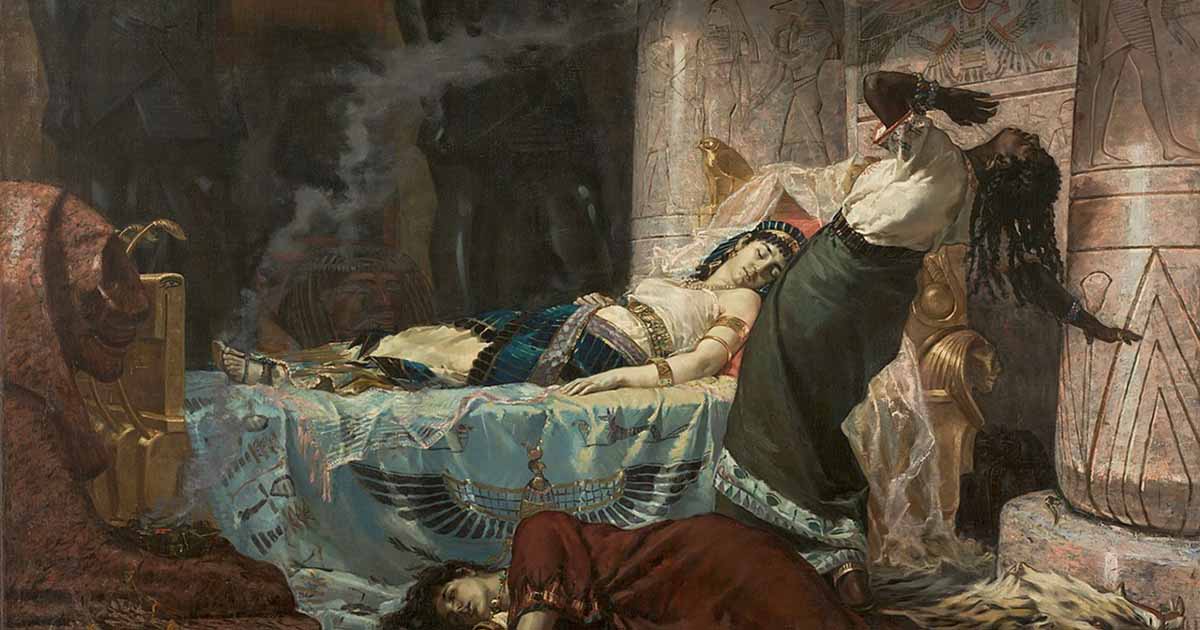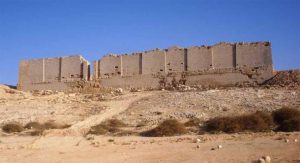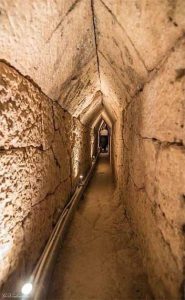The Mysterious Mission: The Hunt for the Lost Tomb of Antony and Cleopatra

When it comes to ancient love stories, few couples have captured the imagination quite like Mark Antony and Cleopatra. Their passionate romance, set against the backdrop of the Roman Empire’s struggles for power, culminated in a tragic end that has fascinated historians for centuries. For almost 2,000 years, their untimely demise has been shrouded in mystery, begging the question of where they were laid to rest. The search for Antony and Cleopatra’s lost tomb has inspired archaeologists to continue digging for answers in the sands of ancient Egypt.
The Downfall of Mark Antony and Cleopatra
Following their devastating defeat at the Battle of Actium in 31 BC, Mark Antony and Cleopatra sought refuge in Egypt, where Cleopatra held the throne as queen. Egypt became their final sanctuary, shielding them from the relentless pursuit of Octavian, the victorious Roman leader who would later become Emperor Augustus. However, their respite was short-lived, as Egypt faced invasion in 30 BC, leading to the climactic Battle of Alexandria. Trapped and facing an inevitable outcome, Antony and Cleopatra met their tragic demise, surrounded by swirling debates among historians about whether their deaths were a result of suicide or murder.
Archaeologists Discover Rare Bronze ‘Lovers’ Coin’ Depicting Mark Antony and Cleopatra
‘Sensational’ Find is NOT Cleopatra’s Tomb, But May Be a Clue
Nevertheless, even in death, Antony and Cleopatra remained inseparable, as historical records attest that they were laid to rest together. Their joint burial is a poignant symbol of their enduring love and shared destiny. However, despite the passage of nearly two millennia, the exact location of their tomb continues to elude discovery, perpetuating the enigma surrounding this ancient historical mystery. The quest to unravel the secret of Antony and Cleopatra’s final resting place persists, captivating the imagination of historians and archaeologists alike, who yearn to unveil the hidden truths buried within the sands of time.

Octavian and Cleopatra by Louis Gauffier, 1787. (Public domain)
The Deaths of Mark Antony and Cleopatra
There are differing narratives and varying interpretations surrounding the deaths of Mark Antony and Cleopatra. Suetonius, in his work The Lives of the Caesars: Augustus, recounts that Octavian forced Antony to commit suicide when he “tried to make terms at the eleventh hour.” Conversely, the Greek historian Plutarch, in The Parallel Lives: Antony, presents an alternative version, asserting that Antony took his own life upon receiving fake news of Cleopatra’s demise. Octavian, recognizing the value of capturing Cleopatra alive, intended to parade her in his triumph to enhance his glory. “He thought it would add greatly to the glory of his triumph if she were led in the procession,” wrote Plutarch.
In his work, Plutarch portrayed Cleopatra’s steadfast resolve to avoid being taken as a captive to Rome, emphasizing her profound attachment to Antony. In a poignant speech prior to her death, Cleopatra expressed her refusal to be separated from him even in death;
“For though in life nothing could part us from each other, in death we are likely to change places; thou, the Roman, lying buried here, while I, the hapless woman, lie in Italy, and get only so much of thy country as my portion.”
On the other hand, the Roman historian Cassius Dio recounted Cleopatra’s vehement aversion to being paraded as a captive through Rome, a fate she would have considered “worse than a thousand deaths.” It was this fear that compelled her to take her own life.
According to popular legend, Cleopatra retreated to her mausoleum to write a farewell letter, entrusting it to a guard for delivery to Octavian. Subsequently, she clasped an asp, a venomous snake, to her bosom, succumbing to its lethal bite. However, not all historical perspectives align on Cleopatra’s cause of death.
An alternative theory suggests that Octavian orchestrated her murder to solidify his control over the empire. Prior to Octavian’s arrival in Alexandria, Cleopatra had sent her son, Caesarion, to Ethiopia for his safety. Tragically, Caesarion was discovered and killed, leading some scholars to propose that Octavian’s guards also murdered Cleopatra. The discovery of Cleopatra’s body alongside two of her maids fuels speculation of foul play rather than suicide.
Even today, historians and scholars continue to debate the true circumstances of their deaths, with the suicide and murder theories both holding sway. While the suicide narrative conveys a tragic end to the passionate lovers, the possibility of political manipulation and assassination adds a layer of intrigue and complexity to the story. Uncovering the truth behind Cleopatra’s fate remains an elusive puzzle that fuels the quest for knowledge and understanding of this captivating era in history.

‘The Meeting of Antony and Cleopatra’, by Lawrence Alma-Tadema. (Public domain)
Historical Records Cite a Joint Burial of Antony and Cleopatra
Historical records reveal a fascinating detail about the fate of Antony and Cleopatra following their tragic deaths. Despite their tumultuous lives and the circumstances surrounding their demise, it is believed that Octavian, the eventual ruler of Rome, allowed the two lovers to be buried together. Accounts from Cassius Dio and Suetonius attest to this joint burial, shedding light on the final resting place of these iconic figures.
Cassius Dio writes that Antony and Cleopatra were both embalmed in a similar manner and interred in the same tomb. This suggests that even in death, they were united, symbolizing their deep connection and shared fate. Suetonius, on the other hand, recounts how Octavian granted them the honor of being buried together, ensuring that the mausoleum they had started to build would be completed. Plutarch’s account adds an intriguing dimension, noting that Octavian respected Cleopatra’s “lofty spirit” and allowed her to be buried alongside Antony, “in splendid and regal fashion,” as befitted their royal status.
The decision to allow Antony and Cleopatra to be laid to rest together speaks to the complex emotions and political considerations surrounding their deaths. Despite their status as enemies of Rome, their love story and larger-than-life personas seemed to have captivated even their adversaries.
After this, Antony and Cleopatra disappear from history, and the whereabouts of their tomb remains unknown. It may be possible that Antony and Cleopatra’s tomb was not constructed as a grand monument, considering that it could be used as a rallying point against Octavian in the future. Hence, the tomb may have been regarded as insignificant, and neither the location nor a description of it was recorded for posterity.
Despite the paucity of surviving information about the actual tomb of Antony and Cleopatra, over the ages people have conjured various depictions of what it might have looked like. One intriguing representation can be found in a 15th-century French manuscript, where an artist captured their imagined vision of the tomb. Reflecting the accounts from ancient sources, the painting portrays the two lovers being buried together, emphasizing their enduring bond even in death. However, it is worth noting that the depiction of the tomb in the European Gothic style is somewhat anachronistic, given the historical context.

View of the Taposiris Magna Osiris Temple, near to which archaeologists believe they have found clues as to the whereabouts of Antony and Cleopatra’s tomb. (Koantao / CC BY-SA 3.0)
The Hunt for Antony and Cleopatra’s Tomb
Despite the enduring interest and fascination surrounding the search for the elusive tomb of Antony and Cleopatra, progress has been disappointingly slow. Some speculations propose that Cleopatra might have been interred in her palace, the very place where she committed suicide. However, the unfortunate fate of this palace lies beneath the sea, raising doubts as to whether any remains of the two lovers would have survived.
In 2009, an announcement by Zahi Hawass stirred excitement as he proposed the possibility of discovering Antony and Cleopatra’s tomb. The suggested site of this monumental discovery was the renowned temple dedicated to Osiris known as Taposiris Magna, which dates back to the reign of Ptolemy II and is situated to the west of Alexandria, the city which has become the most popular contender in the quest to find Antony and Cleopatra’s tomb.
The Dramatic Death of Cleopatra – Was it Really Suicide?
Underground Tunnel Found Beneath Egyptian Temple May Lead to Cleopatra
The speculation surrounding Taposiris Magna as the final resting place of Antony and Cleopatra stemmed from significant findings made at the site. Among the discoveries are a damaged bust believed to depict Cleopatra, 22 coins bearing her image and a mask purportedly linked to Antony. In addition, the excavation yielded 27 tombs and 10 mummies, adding to expectations surrounding the potential identification of the famous couple. However, doubts were raised regarding Hawass’ claim, with some archaeologists questioning the likelihood of Octavian permitting the burial of his defeated adversaries within such a prestigious temple.

Archaeologists hope that the discovery of a long tunnel at Taposiris Magna could lead them to finding Antony and Cleopatra’s lost tomb. (Egyptian Ministry of Tourism and Antiquities)
Then, in a 2019 interview published in Spanish daily El País, Hawass clarified that the idea of finding Antony and Cleopatra’s tomb at Taposiris Magna was actually the brainchild of Kathleen Martínez, the now-famed Dominican archaeologist who has been searching for Cleopatra’s tomb since 2005. Being that Egyptians had not been accustomed to burying their dead at temples, Hawass summarized that it was “unlikely that Cleopatra was buried there.”
Nevertheless, in 2022 there was an apparent breakthrough. “Tunnel discovered beneath Egyptian temple may lead to Cleopatra’s tomb,” announced a CNN report. After nearly two decades searching, Martínez had uncovered a 1,305-meter (4,281-ft) tunnel which the Egyptian Ministry of Tourism and Antiquities dubbed “an engineering miracle.”
At the time, Martínez pointed out a multitude of compelling factors that led her to believe that the elusive tomb of Antony and Cleopatra might be situated within the Temple of Osiris nestled within the ruins of the city of Taposiris Magna. The main reason was the fact that during her era, Cleopatra was described as “the human incarnation of the goddess Isis,” reported CNN.
While the search for the tomb of Antony and Cleopatra has so far not yielded any tangible results, the tantalizing clues and artifacts discovered at Taposiris Magna hint at the possibility of unearthing the long-lost burial site. The tunnel discovered by Martinez has led archaeologists into the Mediterranean Sea, which means that future excavations will take place underwater. Should her hunch prove successful, the discovery could be the most important of the century